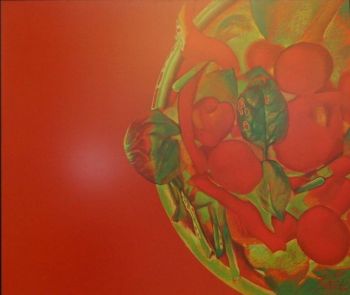Its coordinator is the famous Latvian painter Artur Nikitin, who has succeeded in gathering the brightest and most talented modern artists who work in this unique technique, and created a bright exposition saturated with energy, colours and meaning.

The exhibition presents works of Latvian artists of several generations using a pastel technique, including Dmitry Lavrentyev, Alexander Stepanyan, Juris Germanis, Alla Korolyova, and certainly, Larisa Sheller, Andris Abilevs, Felicita Pauluka, as well as works of the maоtre Artur Nikitin.
When speaking about the exposition, Artur Nikitin notes, “The ‘high spot’ is, in my opinion, masterpieces by Felicita Pauluka, which are loaned by the Latvian National Museum of Art specially for our exhibition. They were created in the mid-1970s. Without this artist, it is hard to understand Latvian art of the 20
th century – she is worthy of respect, both as an artist and as a personality. Her works invariably amaze with refined drawing and a very high culture of performance. Felicita is one of the brightest representatives of professional art of the mid last century.”
The coordinator specifically notes the ‘reverently tender’ portrait of Germanis and his two beautiful academy figures, works of the young participant of the exhibition Larisa Sheller, as well as works of Natalya Bessonova devoted to the George Balanchine’s ballet “Jewels”
. “These pastels strike with their extraordinary saturation – Natalya masterfully works with colours, her paintings display a play with light,” states the maоtre.
The exhibition is completed with the works of the maоtre – Artur Nikitin, who acknowledges that he finds himself to be a workaholic, who works intensively not due to some sort of contrived necessity, but feeling a biological and physiological need. This time the artist, according to his own words, “wanted very much to show the work devoted to Shostakovich and his “Leningrad Symphony” (Symphony No. 7), which had become a symbol of the spiritual strength of the Russian people during World War Two.” And it is not accidental, as the native city of Nikitin is Leningrad.
Among the works of the maоtre, one can see a portrait of Joseph Brodsky, who, as Artur Nikitin recollects, used to come to his small flat in the Old Town and read his unrivalled poems, “Listening to him was totally spellbinding. He had amazing perception – he started unexpectedly very quietly, then raised his voice, and, when entering the “poetic ecstasy”, he was crying loudly, and I was afraid all the time that neighbours would come… I remembered him like that for my entire life – a man of solid build, with piercing grey eyes and red hair – and this is how I portrayed him.” When speaking about his painting “Lolita”, the artist said, “A woman’s body is a divine invention of the Lord. Everything that is beautiful in nature and art has been, in my opinion, inspired and created based on sensual versatility and richness, and the harmony of a woman’s body.”
A special exhibition devoted to pastel technique is arranged by a group of Latvian artists for the first time
. Pastel originates from drawing by using soft materials – sepia, fusain, sanguine, a charcoal crayon. Soft pastel contains practically the same pigments that are applied in oil paints – the only difference is in the absence of oil. Pastel is well known with its bright and saturated colour; it is exquisite in work, renders richness of colours and a velvety texture. This technique appeared a long time ago; one of its bright representatives is the French painter Edgar Degas. Now, pastel, regrettably, has been unheralded, and it is a rare chance to see works by modern artists made in this technique.
The exhibition will be open until 9 October, on weekdays from 9 a.m. till 6 p.m. Admission, as always, is free. Venue: Headquarters of the bank – Rietumu Capital Centre, 7 Vesetas Street, Riga. Eleonora Gailisha Mass Media and Public Relations
Phone: +371-67020506
Fax: +371-67020563
E-mail:
[email protected]
